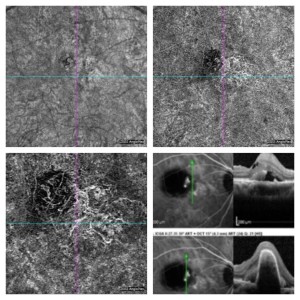 There is an exciting advancement in retinal imaging in ophthalmology, and it has already reached Hawaii at Retina Consultants of Hawaii, Inc.
There is an exciting advancement in retinal imaging in ophthalmology, and it has already reached Hawaii at Retina Consultants of Hawaii, Inc.
Currently, the only option for imaging of the retinal and choroidal vasculature is through fluorescein angiography (FA) and indocyanine green angiography (ICG). These imaging modalities are used to diagnose and manage diseases of the posterior segment. Both FA and ICG produce detailed and valuable images and information for the ophthalmologist, but aree invasive for patients and time-consuming in clinic. It requires an injection of sodium fluorescein dye and indocyanine green into the patient’s bloodstream, in order to view blood vessels in the retina and choroid. Infrequentlythe dyes have side effects such as nausea, vomiting, and rarely an allergic anaphylactic reaction. A careful injection of dye by a skilled photographer takes time in a busy clinic.
Recently, Carl Zeiss Meditec, Inc. has developed a new imaging technology that could possibly replace the gold standard of FA and ICG. It is called optical coherence tomography angiography (OCTA). It is non-invasive for the patient and does not require an injection of dye. Instead, OCTA follows a similar method to imaging techniques of the general OCT, but OCTA provides visualization of microvascular blood flow.
OCT Angiography has many potential advantages to traditional imaging techniques. Not only is it capable of showing vascular abnormalities, it can also create intensity based OCT cross sections and en face visualization that can identify structural changes such as increased retinal thickness. Blood flow can also be detected in three dimensions on OCTA, giving depth information. In FA and ICG, all depths are combined in one image. One slight disadvantage of the current OCTA technology is that it cannot give detailed information on leakage, because leakage is slow in the retina. However, the OCTA technology can detect signs of leakage.
RCH received the new OCTA technology in early October. Dr. Gregg Kokame is optimistic for OCTA technology to continue to advance his world-known research in polypoidal choroidal vasculopathy.

No comments yet.